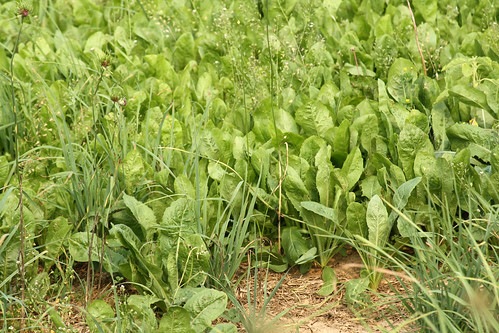
 Temperatures are in the mid to upper 80's. The goats are making good use of the port-a-hut shelters. We are in the process of erecting a 20 x 20 ft. shade structure for them. While the port-a-huts are adequate, the shade structure should improve their comfort level. Goats perform better when they are cooler.
Temperatures are in the mid to upper 80's. The goats are making good use of the port-a-hut shelters. We are in the process of erecting a 20 x 20 ft. shade structure for them. While the port-a-huts are adequate, the shade structure should improve their comfort level. Goats perform better when they are cooler. The grasses, mostly orchardgrass and MaxQ™ tall fescue are very tall. We'd like to start the test in May next year to take advantage of the early spring growth. The pearl millet that was planted recently is coming up nicely. It will provide excellent forage when the cool season grasses taper off during the middle of the summer.
The grasses, mostly orchardgrass and MaxQ™ tall fescue are very tall. We'd like to start the test in May next year to take advantage of the early spring growth. The pearl millet that was planted recently is coming up nicely. It will provide excellent forage when the cool season grasses taper off during the middle of the summer.
 The chicory will soon be ready for grazing. If managed properly, the leafy growth of chicory is higher in nutritive and mineral content than is produced by alfalfa or cool season grasses. It has a relatively deep taproot system which provides for drought tolerence. Many farmers and agronomists consider chicory to be a weed, but it is an excellent forage for small ruminants, with the added benefit of having "anthelmintic-like" properties. The goats love it.
The chicory will soon be ready for grazing. If managed properly, the leafy growth of chicory is higher in nutritive and mineral content than is produced by alfalfa or cool season grasses. It has a relatively deep taproot system which provides for drought tolerence. Many farmers and agronomists consider chicory to be a weed, but it is an excellent forage for small ruminants, with the added benefit of having "anthelmintic-like" properties. The goats love it. The goats will be worked next on Friday, June 20, beginning at 7 a.m.. Starting weights will be obtained. It is expected that some goats will have lost weight during the 13-day adjustment period, especially those that have been on a higher nutritional plane and are carrying more body condition.
The goats will be worked next on Friday, June 20, beginning at 7 a.m.. Starting weights will be obtained. It is expected that some goats will have lost weight during the 13-day adjustment period, especially those that have been on a higher nutritional plane and are carrying more body condition. Due to the double deworming, we don't expect to deworm any of the goats for some time. We will continue to collect fecal samples and record body condition and FAMACHA© scores.
Due to the double deworming, we don't expect to deworm any of the goats for some time. We will continue to collect fecal samples and record body condition and FAMACHA© scores.View all pictures of 2008 goat test on Flickr™











